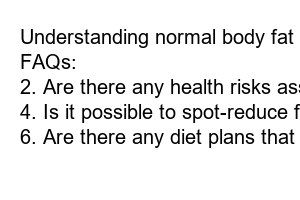체지방률 정상범위
Title: Understanding Normal Body Fat Percentage: A Comprehensive Guide
Introduction:
Maintaining a healthy body fat percentage is essential for overall well-being. However, determining what is considered a normal body fat percentage can be confusing. In this blog post, we will delve into the topic, providing vital insights and guidance to help you achieve a healthier body composition.
1. What is Body Fat Percentage?
Body fat percentage refers to the proportion of fat mass relative to the total body weight. It is an important measurement of health and fitness, as excessive body fat has been linked to various health issues, including heart disease and diabetes.
2. How is Body Fat Percentage Measured?
There are several methods to measure body fat percentage, including skinfold calipers, bioelectrical impedance analysis, dual-energy X-ray absorptiometry (DEXA), and hydrostatic weighing. Each method has its pros and cons, but all aim to accurately determine the body’s fat levels.
3. What is the Normal Body Fat Percentage Range?
The normal body fat percentage range varies depending on factors such as age, gender, and fitness level. For adult males, a healthy range is typically around 10-20%, while for adult females, it is closer to 20-30%. It is crucial to note that these ranges can be subjective and may fluctuate based on individual circumstances.
4. Tips for Maintaining a Healthy Body Fat Percentage:
– Engage in regular physical activity: Combining cardiovascular exercise with strength training can help build lean muscle mass, which in turn can aid in reducing body fat levels.
– Follow a balanced diet: Opt for nutrient-dense foods, incorporating a variety of fruits, vegetables, whole grains, lean proteins, and healthy fats into your meals.
– Stay hydrated: Getting enough water throughout the day supports overall health and metabolism, aiding in weight management and fat loss.
– Get enough sleep: Studies have shown that inadequate sleep can disrupt hormonal balance and contribute to weight gain and increased body fat percentage.
5. Is Body Mass Index (BMI) a Reliable Indicator of Body Fat Percentage?
Although widely used, BMI alone is not an accurate measure of body fat percentage. BMI relies solely on height and weight, disregarding factors such as muscle mass and distribution of fat. Individuals with high muscle mass may have a higher BMI despite having a healthy body fat percentage.
6. Understanding the Factors Affecting Body Fat Percentage:
Genetics, age, hormonal imbalances, and lifestyle choices all play a role in body fat composition. Accepting your genetic predisposition while focusing on a healthy lifestyle can help you achieve a balanced body fat percentage that suits your individual needs.
Summary:
Understanding normal body fat percentage is vital for achieving optimal health and well-being. By employing methods to accurately measure body fat and adopting healthy lifestyle choices, such as regular exercise and a balanced diet, you can strive towards maintaining a healthy body composition. Remember, individual circumstances may influence what is considered normal for you, so consult with a healthcare professional for personalized guidance.
FAQs:
1. Can body fat percentage be reduced solely through exercise?
2. Are there any health risks associated with having a low body fat percentage?
3. How does body fat percentage affect athletic performance?
4. Is it possible to spot-reduce fat in specific areas of the body?
5. Can body fat percentage be increased with age?
6. Are there any diet plans that specifically target reducing body fat percentage?

